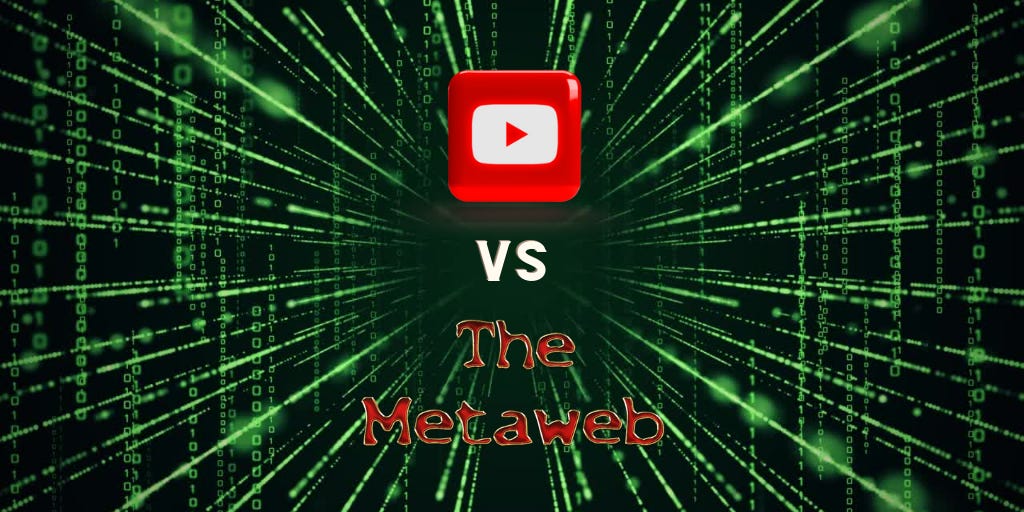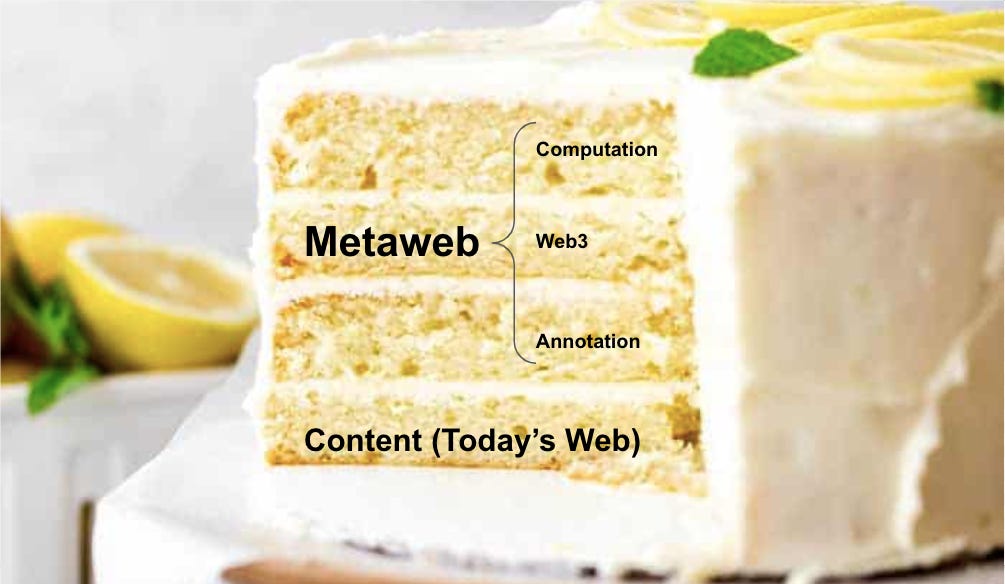YouTube and the Metaweb both employ attention triggering to provide contextual info and garner attention.
TL;DR: The attention-triggered controls of the YouTube video player that appear upon demand are centralized examples of the types of controls (i.e., smart tags) that are decentralized in Web4.
Imagine you are watching a Youtube video and you realize that you want to interact with the video. Maybe you want to pause it, change the volume, jump to the next video or see how much time is left. Maybe you want to see where you are in the video or what parts of the video are most replayed. Maybe you just want to skim the thumbnails in the rest of the video. Maybe you want to change the volume. Maybe you want to add closed captions, display annotations, change the playback speed, add subtitles, change language, or change the video quality. Or maybe you want to display the video in the mini-player, theater mode, or full-screen.
These potential interactions have several things in common. First, they control the YouTube video player. These controls are designed to improve your personal viewing experience with the video like the remote control of a television. Second, they are Web2 tech. Web2 is built on centralized servers controlled by Internet platforms such as YouTube and leverages web scripting languages to change the display without reloading the entire page. Third, these interactions are attention-triggered. The notion of attention may have come into your field recently. Perhaps you saw the Social Dilemma on Netflix or heard someone saying that Today’s Web is an attention economy.
Attention Triggering
You probably haven't heard much about attention triggering, despite its prevalence in Web2. Internet platforms, website as a service, UX/UI specialists, corporate site builders, mobile app developers, and advertisers all rely heavily on attention triggering to improve the web experience.
Attention-triggered elements on the web page change their behavior ー often appearing or moving ー in response to the user's attention. On a laptop or desktop, attention is represented by the cursor; on mobile, it’s touch; in the Metaverse, it will be line-of-sight. In YouTube, the video player controls only display when you are focusing your attention on them. Move your attention and they are gone. The purpose of using attention-triggered controls is to only display the controls when you need them, rather than have them as a distraction in your visual field while you are watching the video.
Notice how the controls in the bottom third appear and respond to the cursor.
As you can see in the animated graphic above, at first, you can't see the controls. When, however, attention in the form of the cursor moves to the video, the video controls appear.
We don't even think about it. As web users, we are accustomed to using our attention to signal interest in web applications.
When the cursor touches any part of the video, the control bar appears. Suppose you move your attention to the timeline. In that case, the thumbnail associated with the specific time will appear a bit above the timeline and, assuming sufficient data exists, a graph showing how much each moment has been replayed will appear directly above the timeline. Moving along the timeline displays different thumbnails for each moment in time.
This Web2 tech uses the common web scripting language, Javascript, which is also used to display videos, advertisements, and content over web content and links, as well as short explanations associated with, for example, onboarding tutorials and tooltips. These are Web2 because they are centralized and controlled by the Javascript code embedded in the web page.
Decentralized Controls
In Web4, attention-triggered information and interactions ー such as controls associated with videos, any other type of content, contextual information, and advertisements ー are decentralized. Any participant can add attention-triggered information and interactions associated with web page content in a layer above the web page. In this way, Web4 decentralizes the space above the web page, which we call the Metaweb. The Metaweb is not just another siloed website or dApp. The Metaweb is active above every web page. In fact, it is the space above the web page.
The Metaweb comprises annotation, Web3, and computation above the web page.
Disclaimer: One of our projects is building the first full instantiation of the Metaweb, which we have coined the Overweb. Presence DAO is building a browser overlay that is accessible as a browser extension, through web pages with the Canopi Enterprise SDK loaded, soon through a mobile app, and eventually web browsers that adopt the Overweb protocol. The Overweb’s utility token (OWEB) will be a fair-launch reflection token with a stable coin counterpoint pegged and backed by NEAR’s stable coin (USN). Stay tuned for alpha.
Whereas today’s Web2 attention-triggered controls generally focus on improving the user's direct experience with the content, Web4 equivalents are social in nature and are designed to improve individual and collective productivity. As mentioned above, YouTube controls are designed to improve the user’s viewing experience, for example, by adding subtitles or adjusting playback speed. Web4 controls for a video might enable people to discuss the video or specific segments, interact with polls about segments, leave notes on segments, and bridge from specific segments to related content.
Back to the Future
Web4 controls for a video might also enable participants to create associative trails of content from video segment to video segment or even to non-video content, as originally envisioned in Vannevar Bush’s seminal computing article As We May Think, which was published by The Atlantic in July 1945. This speculative article birthed the development of the Web, inspiring Douglas Engelbart and later Ted Nelson to develop the modern workstation and Hypertext technology.
Web4, in fact, marks the emergence of collective computing, first articulated in Englebart’s 1962 conceptual framework for Augmenting Human Intellect. Doug’s goal from the outset was exploring better ways for people to work together on complex and urgent challenges. He foresaw that the acceleration of change due to technology would lead to planetary-scale problems that require a collective response. His aim was to enable humanity to think, learn, and build knowledge together.
Rather than simply enabling people to get collectively smarter in addressing global challenges, Doug wanted to teach humanity how-to get smarter about getting smarter. In other words, in addition to teaching humanity “how-to-fish”, Doug wanted to teach humanity “how-to-continously-fish-more-effectively”.
In Web4, the participant (rather than the pejorative user) can access attention-triggered controls that bring the web to life. In the future, a piece of content on a web page can be the contextual footprint for Nelsonian “intertwingled” worlds of relevant information and interactions that emanate from the content on the page.
“Web4 works like the controls on YouTube but anyone can place them and they are here to help us think together at scale” ~ Daveed Benjamin, inventor of Web4
The content can be a headline, a sentence, or a phrase in an article, an image or a piece of an image, a video or a segment of a video, a part of a song or a podcast, or a tweet. Relevant information can be supporting or contradicting evidence to a claim, citations, other related information, or simply an invitation to go down a rabbit hole. Relevant interactions can be commenting on a note, participating in a conversation, responding to a poll, joining an online meeting, classifying content on pages for AI, and reporting a crypto scam site, for example.
The Possibilities are Endless
Not only does everyone have access to the controls, everyone has the capability to place the overlay controls on any content on any web page. In the Overweb, these are called smart tags. Beyond just participating in a conversation on a controversial news story, you can attach a conversation smart tag to a particular claim, add a poll smart tag related to the claim, or even make a bridge smart tag to a piece of evidence that contradicts or supports the claim.
As the Metaweb matures, developers (and eventually participants using a drag & drop no-code interface) will create a universe of smart tags, usable by anyone on any web page. In every industry, web-forward startups and developers will build open-source smart tags that can be leveraged for future Metaweb dApps. The limit will be only in our collective imagination, which will only grow as we make our thinking visible above web pages using smart tags.
In sum, Web4 is a hyper-dimensional web that creates decentralized public space above every web page. Web4 builds on and over Today’s Web ー in which the web experience is constrained by the code of the web page ー by locating a decentralized web layer above the Web where participants can place information and interactions (i.e., computational code) above specific content on any web page. While Web4 controls appear in a similar fashion as the attention-triggered controls of a YouTube video, Web4 smart tags are decentralized and will enable humanity to think, learn, and build knowledge together at scale for the first time.
Free Metaweb Pioneers: Web4 NFT
The Metaweb news stream wants to answer any questions you may have about the next level of the Web. We’d love to hear what you think about Web4 and the Metaweb. If you see the Metaweb’s potential to catalyze a new web paradigm, you’ll want the inaugural NEAR Web4 NFT. And you’ll have to earn it ー with a good question.
The Metaweb is the space above the web page; a meta layer connecting the entire web; literally the next level of the Web & the leading contender to be Web4.
Serious, timely questions about Web4 in a comment on this post, a retweet for the @presencebrowser tweet, or a reply on this Instagram post receive the inaugural NEAR Web4 NFT.
The Metaweb Book
Stay Tuned for the forthcoming book from Bridgit DAO, “The Metaweb: The Next Level of the Internet” (to be published in Q1 2023 by Taylor & Francis). Accompanying the book will be a pre-sale collection of generative Metaweb NFTs, which earn book and NFT royalties when staked. For more info, join the wait list at https://bridgit.io/metaweb-book.
Please tell us what you think
We’d love to know what you think. Please make a comment in which you identify one or more Web4 interactions that would make for a more rich, productive and collective experience of a specific video the caught your attention. Insightful comments earn a Metaweb Pioneers NFT. Tell us: What is the video? When you watch and/or re-watch the video, what information would be useful? What do want to know? What types of interactions would be valuable? What do you want to do?









I feel like this too will become monopolized; Unless, there are built in fail-safes such as each user being part owner to avoid the potential of a buyout or merger with current monopolistic entities that share the namesake, especially...